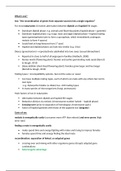Lecture notes
Optimisation of Behaviour: Sex, Behaviour and Life Histories Revision Notes
- Module
- Institution
- Book
A full compilation of all 15 lectures of the University of Bristol course 'Optimisation of Behaviour: Sex, Behaviour and Life Histories'. Independent reading is included (highlighted in yellow). The module focuses on the evolution and maintenance of sex.
[Show more]













